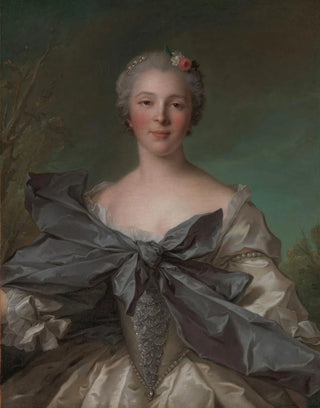Art print | Marie Françoise de La Cropte de St Abre Marquise d'Argence born 1714 - Jean-Marc Nattier


View from behind

Frame (optional)
In the fascinating world of art, some works transcend time and continue to captivate the minds of enthusiasts and connoisseurs. Among these treasures, the depiction of Marie Françoise de La Cropte de St Abre, Marquise d'Argence, by Jean-Marc Nattier, stands out for its elegance and narrative richness. This portrait, created in the 18th century, evokes not only the beauty of its subject but also the art of living of an era marked by refinement and sophistication. Delving into this piece, one discovers a window into the past, a testament to feminine identity and the role of women in the aristocratic society of the time.
Style and uniqueness of the work
Nattier's style is characterized by unmatched delicacy and precision, which manifest in every detail of his painting. The soft light bathing Marie Françoise's face, along with the sumptuous drapery of her gown, creates an atmosphere of grace and serenity. The artist excels in depicting textures, making the richness of fabrics and the luminosity of colors almost tangible. Through this portrait, Nattier manages to capture not only the physical beauty of the marquise but also her essence, character, and social status. The choice of accessories, such as delicate jewelry and floral elements, emphasizes her refinement and elegance, while also reflecting her role as an influential woman of her time.
The artist and his influence
Jean-Marc Nattier, one of the most prominent portraitists of the 18th century, established himself as a master in aristocratic portraiture. Trained at the Royal Academy of Painting and Sculpture, he was heavily influenced by the great masters of classical painting, while developing a style that was uniquely his own. Nattier was able to capture the spirit of his era, blending the idealization of figures with a more intimate and personal approach. His portraits, often commissioned by high nobility, reflect not only the external beauty of his subjects but also their character and their

Matte finish

View from behind

Frame (optional)
In the fascinating world of art, some works transcend time and continue to captivate the minds of enthusiasts and connoisseurs. Among these treasures, the depiction of Marie Françoise de La Cropte de St Abre, Marquise d'Argence, by Jean-Marc Nattier, stands out for its elegance and narrative richness. This portrait, created in the 18th century, evokes not only the beauty of its subject but also the art of living of an era marked by refinement and sophistication. Delving into this piece, one discovers a window into the past, a testament to feminine identity and the role of women in the aristocratic society of the time.
Style and uniqueness of the work
Nattier's style is characterized by unmatched delicacy and precision, which manifest in every detail of his painting. The soft light bathing Marie Françoise's face, along with the sumptuous drapery of her gown, creates an atmosphere of grace and serenity. The artist excels in depicting textures, making the richness of fabrics and the luminosity of colors almost tangible. Through this portrait, Nattier manages to capture not only the physical beauty of the marquise but also her essence, character, and social status. The choice of accessories, such as delicate jewelry and floral elements, emphasizes her refinement and elegance, while also reflecting her role as an influential woman of her time.
The artist and his influence
Jean-Marc Nattier, one of the most prominent portraitists of the 18th century, established himself as a master in aristocratic portraiture. Trained at the Royal Academy of Painting and Sculpture, he was heavily influenced by the great masters of classical painting, while developing a style that was uniquely his own. Nattier was able to capture the spirit of his era, blending the idealization of figures with a more intimate and personal approach. His portraits, often commissioned by high nobility, reflect not only the external beauty of his subjects but also their character and their






